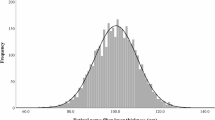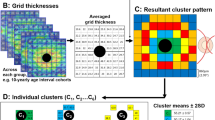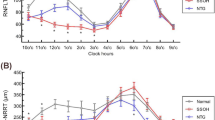Abstract
Purpose
To evaluate the presence of retinal nerve fibre layer (RNFL) defects in patients with X-linked retinoschisis (XLRS) using high-speed, high-resolution, Fourier domain OCT (FD-OCT).
Methods
Twenty-four patients with XLRS seen by the authors were enroled in the study. All patients underwent a complete eye examination. FD-OCT was performed using Optovue technology. A quadrant of the RNFL was considered to be thinned if at least two of the four segments in the quadrant were reduced in thickness.
Results
The average age of the 24 patients in the study was 28.8±14.7 years. Thinning of the RNFL in one quadrant was seen in 10 patients (41.7%), and thinning in two or more quadrants was seen in 8 patients (33.3%). Thinning in the inferior quadrant was most commonly seen and was observed in 12 patients (50%), followed by the temporal quadrant in 8 patients (33.3%), nasal quadrant in 4 patients (16.7%), and the superior quadrant in 4 patients (16.7%).
Conclusions
Among our 24 patients with XLRS, 15 patients (62.5%) showed a thinning of the RNFL in one or more quadrants in at least one eye and 9 patients (37.5%) in both eyes. High-speed, high-resolution FD-OCT may be useful to determine the presence of possible changes in RNFL thickness in patients with XLRS. Reductions in RNFL thickness in such patients could be relevant in their selection for future therapeutic trials.
Similar content being viewed by others
Log in or create a free account to read this content
Gain free access to this article, as well as selected content from this journal and more on nature.com
or
References
Haas J . Ueber das Zusammenvorkommen von Veränderungen der Retina und Chorioidea. Arch Augenheikd 1898; 37: 343–348.
Mann I, MacRae A . Congenital vascular veils in the vitreous. Br J Ophthalmol 1938; 22: 1–10.
Renner AB, Kellner U, Fiebig B, Cropp E, Foerster MH, Weber BH . ERG variability in X-linked congenital retinoschisis patients with mutations in the RS1 gene and the diagnostic importance of fundus autofluorescence and OCT. Doc Ophthalmol 2008; 116: 97–109.
Sauer CG, Gehrig A, Warneke-Wittstock R, Marquardt A, Ewing CC, Gibson A et al. Positional cloning of the gene associated with X-linked juvenile retinoschisis. Nat Genet 1997; 17: 164–170.
Grayson C, Reid SN, Ellis JA, Rutherford A, Sowden JC, Yates JR et al. Retinoschisin, the X-linked retinoschisis protein, is a secreted photoreceptor protein, and is expressed and released by Weri-Rbs1 cells. Hum Mol Genet 2000; 9: 1873–1879.
Reid SN, Yamashita C, Farber DB . Retinoschisin, a photoreceptor-secreted protein, and its interaction with bipolar and Müller cells. J Neurosci 2003; 23: 6030–6040.
Molday LL, Hicks D, Sauer CG, Weber BH, Molday RS . Expression of the X-linked retinoschisis protein RS1 in photoreceptor and bipolar cells. Invest Ophthalmol Vis Sci 2001; 42: 816–825.
Reid SN, Akhmedov NB, Piriev NI, Kozak CA, Danciger M, Farber DB . The mouse X-linked juvenile retinoschisis cDNA: expression in photoreceptors. Gene 1999; 227: 257–266.
Weber BH, Schrewe H, Molday LL, Gehrig A, White KL, Seeliger MW et al. Inactivation of the murine X-linked juvenile retinoschisis gene, Rs1h, suggests a role of retinoschisin in retinal cell layer organization and synaptic structure. Proc Natl Acad Sci USA 2002; 99: 6222–6227.
Yanoff M, Rahn EK, Zimmermann LE . Histopathology of juvenile retinoschisis. Arch Ophthalmol 1968; 79: 49–53.
Manschot WA . Pathology of hereditary juvenile retinoschisis. Arch Ophthalmol 1972; 88: 131–138.
Condon GP, Brownstein S, Wang NS, Kearns AF, Ewing CC . Congenital hereditary (juvenile X-linked) retinoschisis. Histopathologic and ultrastructural findings in three eyes. Arch Ophthalmol 1986; 104: 576–583.
Kirsch LS, Brownstein S, de Wolff-Rouendaal D . A histopathological, ultrastructural and immunohistochemical study of congenital hereditary retinoschisis. Can J Ophthalmol 1996; 31: 301–310.
Ozdemir H, Karacorlu S, Karacorlu M . Optical coherence tomography findings in familial foveal retinoschisis. Am J Ophthalmol 2004; 137: 179–181.
Brucker AJ, Spaide RF, Gross N, Klancnik J, Noble K . Optical coherence tomography of X-linked retinoschisis. Retina 2004; 24: 151–152.
Azzolini C, Pierro L, Codenotti M, Brancato R . OCT images and surgery of juvenile macular retinoschisis. Eur J Ophthalmol 1997; 7: 196–200.
Apushkin MA, Fishman GA, Janowicz MJ . Correlation of optical coherence tomography findings with visual acuity and macular lesions in patients with X-linked retinoschisis. Ophthalmology 2005; 112: 495–501.
Gerth C, Zawadzki RJ, Werner JS, Héon E . Retinal morphological changes of patients with X-linked retinoschisis evaluated by Fourier-domain optical coherence tomography. Arch Ophthalmol 2008; 126: 807–811.
Parikh RS, Parikh SR, Sekhar GC, Prabakaran S, Babu JG, Thomas R . Normal age-related decay of retinal nerve fiber layer thickness. Ophthalmology 2007; 114: 921–926.
Budenz DL, Anderson DR, Varma R, Schuman J, Cantor L, Savell J et al. Determinants of normal retinal nerve fiber layer thickness measured by Stratus OCT. Ophthalmology 2007; 114: 1046–1052.
Bayraktar S, Bayraktar Z, Yilmaz OF . Influence of scan radius correction for ocular magnification and relationship between scan radius with retinal nerve fiber layer thickness measured by optical coherence tomography. J Glaucoma 2001; 10: 163–169.
Sony P, Sihota R, Tewari HK, Venkatesh P, Singh R . Quantification of the retinal nerve fibre layer thickness in normal Indian eyes with optical coherence tomography. Indian J Ophthalmol 2004; 52: 303–309.
Acknowledgements
This work was supported by funds from the Foundation Fighting Blindness, Owings Mills, MD; Grant Healthcare Foundation, Lake Forest, IL; NIH core grant EYO1792; and an unrestricted departmental grant from the Research to Prevent Blindness.
Author information
Authors and Affiliations
Corresponding author
Additional information
Proprietary interest: None.
Rights and permissions
About this article
Cite this article
Genead, M., Pasadhika, S. & Fishman, G. Retinal nerve fibre layer thickness analysis in X-linked retinoschisis using Fourier-domain OCT. Eye 23, 1019–1027 (2009). https://doi.org/10.1038/eye.2009.53
Received:
Revised:
Accepted:
Published:
Issue date:
DOI: https://doi.org/10.1038/eye.2009.53
Keywords
This article is cited by
-
Thinner temporal peripapillary retinal nerve fibre layer in Stargardt disease detected by optical coherence tomography
Graefe's Archive for Clinical and Experimental Ophthalmology (2021)



